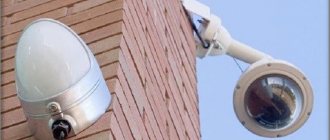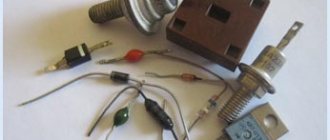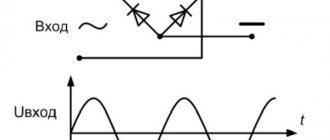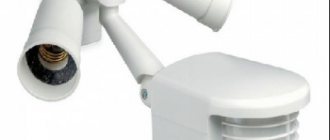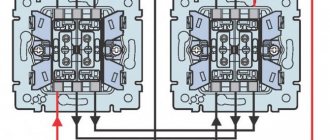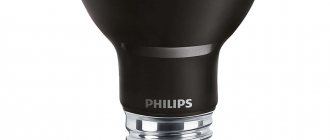It is unwise to turn on lighting in some rooms or outdoors for the entire dark period. To ensure that the light turns on only when needed, a motion sensor is installed in the lamp’s power circuit. In the “normal” state, it breaks the power circuit. When a moving object appears in its coverage area, the contacts close and the lighting turns on. After the object disappears from the coverage area, the light turns off. This operating algorithm has proven itself excellent in street lighting, in lighting utility rooms, corridors, basements, entrances and stairs. In general, in those places where people appear only periodically. So, for savings and convenience, it is better to install a motion sensor to turn on the light.
Types and varieties
Motion sensors for turning on lights can be of different types, designed for different operating conditions. First of all, you need to look at where the device can be installed.
A motion sensor to turn on the lights is needed not only on the street
Outdoor motion sensors have a high degree of housing protection. For normal use outdoors, take sensors with an IP of at least 55, but better - higher. For installation in a home, you can take IP 22 and higher.
Power type
Next, you need to consider what source the light sensor is powered from. There are the following options:
- Wired sensors powered by 220 V.
- Wireless, powered by batteries or rechargeable batteries.
Motion sensors are wired and wireless
The largest group is wired for connecting to 220 V. There are fewer wireless ones, but there are also enough of them. They are good if you need to turn on lighting powered by low-voltage power sources - rechargeable batteries or solar panels, for example.
Method for determining the presence of motion
The motion sensor for turning on the light can detect moving objects using various detection principles:
- Infrared motion sensors. They react to the heat generated by the body of warm-blooded creatures. They are classified as passive devices, since they themselves do not produce anything, they only register radiation. These sensors also react to the movement of animals, so there may be false alarms.
- Acoustic motion (noise) sensors. Also belongs to the passive group of equipment. They react to noise and can be turned on by a clap or the sound of a door opening. They can be used in the basements of private houses, where noise occurs as soon as someone enters there. Use elsewhere is limited.
The operation of infrared motion sensors is based on tracking the heat generated by a person - Microwave motion sensors. Belong to the group of active devices. They themselves produce waves in the microwave range and monitor their return. In the presence of a moving object, contacts are closed/opened (there are different types). There are sensitive models that “see” even through partitions or walls. Typically used in security systems.
- Ultrasonic. The principle of operation is the same as that of microwaves, but the range of emitted waves is different. This type of device is rarely used, since animals can react to ultrasound, and long-term exposure to humans (the devices constantly generate radiation) will not bring any benefit.
Various designs, but the color is mainly white and black - Combined (dual). Combines several motion detection methods. They are more reliable, have fewer false positives, but are also more expensive.
Most often, infrared motion sensors are used to turn on lights on the street or at home. They have a low price, a large range of action, and a large number of adjustments that will help you customize it. On stairs and in long corridors it is better to install a sensor with ultrasound or microwave. They are able to turn on the lighting even if you are still far from the light source. Microwaves are recommended for installation in security systems - they detect movement even behind partitions.
Example No. 1: HC-SR501 as a standalone device.
Required parts: ► Motion sensor HC-SR501 x 1 pc. ► Relay module (1 channel) x 1 pc. ► Transistor 2SC1213 x 1 pc. ► Lamp 220V (75W) with socket x 1 pc. ► Power supply 5V x 1 pc. ► DuPont wire, 2.54 mm, 20 cm, FM (Female - Male) x 1 pc.
Connection: When you turn on the HC-SR501, calibration is required, it takes from 30 to 60 seconds, and the sensor also has a “reboot” period of about 6 seconds (after activation), during which time it does not respond to movements. In this example we use HC-SR501 and a relay module (1-channel), as well as an NPN transistor (in the example we use 2SC1213). The HC-SR501 sensor is powered from 5 V, since the relay also requires the same power, and a 220V lamp is used as a load. Since the output signal of the HC-SR501 is weak (in practice it is only enough to light the LED), one option is to use any bipolar NPN transistor.
Attention! Follow safety precautions and be careful!
The operation of this circuit is very simple, after switching on and calibrating, the sensor begins to read readings. When motion is detected, the sensor changes the value at the “OUT” pin.
Specifications
Once you have decided which motion sensor you will install to turn on the lights, you need to select its technical characteristics.
The technical characteristics of wireless models also include the frequency at which they operate and the type of batteries
Viewing angle
The motion sensor for turning on the light can have a different viewing angle in the horizontal plane - from 90° to 360°. If an object can be approached from any direction, sensors with a radius of 180-360° are installed, depending on its location. If the device is mounted on a wall, 180° is enough, if on a pole, 360° is already needed. Indoors, you can use those that track movement in a narrow sector.
Depending on the installation location and the required detection zone, select the viewing radius
If there is only one door (a utility room, for example), a narrowband sensor may be sufficient. If the room can be entered from two or three sides, the model should be able to see at least 180°, and better yet, in all directions. The wider the coverage, the better, but the cost of wide-angle models is much higher, so you should proceed from the principle of reasonable sufficiency.
There is also a vertical viewing angle. In ordinary inexpensive models it is 15-20°, but there are models that can cover up to 180°. Wide-angle motion detectors are usually installed in security systems, and not in lighting systems, since their cost is considerable. In this regard, it is worth choosing the correct height for installing the device: so that the “dead zone”, in which the detector simply does not see anything, is not in the place where the movement is most intense.
Range
Here again, you should choose taking into account whether a motion sensor will be installed indoors to turn on the lights or outdoors. For indoor environments, a range of 5-7 meters is sufficient.
Choose range with reserve
For the street, it is desirable to install more “long-range” ones. But look here too: with a large coverage radius, false positives can be very frequent. So having too much coverage can even be a disadvantage.
Power of connected luminaires
Each motion sensor for turning on the light is designed to connect a certain load - it can pass a current of a certain rating through itself. Therefore, when choosing, you need to know the total power of the lamps that the device will connect.
The power of the connected lamps is critical if a group of lamps or one powerful one is turned on
In order not to overpay for the increased capacity of the motion sensor, and even save on electricity bills, use not incandescent lamps, but more economical ones - gas discharge, fluorescent or LED.
Installation method and location
In addition to the obvious division into street and “home”, there is another type of division according to the location of installation of motion sensors:
- Case models. A small box that can be mounted on a bracket. The bracket can be fixed: on the ceiling;
- on the wall.
The type of motion sensor cannot be determined by its appearance, you can only understand whether it is installed on the ceiling or on the wall
If the lighting is turned on only to increase comfort, cabinet models are chosen, since they are cheaper with equal characteristics. Built-in ones are installed in security systems. They are miniature, but more expensive.
Additional functions
Some motion detectors have additional features. Some of them are obvious overkill, others, in certain situations, can be useful.
- Built-in light sensor. If a motion sensor to turn on the light is installed on the street or in a room with a window, there is no need to turn on the light during daylight hours - the illumination is sufficient. In this case, either a photo relay is built into the circuit, or a motion detector with a built-in photo relay is used (in one housing).
- Protection from animals. A useful feature if you have cats or dogs. With this function there are much fewer false positives. If the dog is large, even this option will not save you. But it works well with cats and small dogs.
For many, a useful feature would be protection against triggering when animals appear. - Light off delay. There are devices that turn off the light immediately after the object leaves the coverage area. In most cases this is inconvenient: light is still needed. That’s why models with a delay are convenient, and even more convenient are those that allow you to adjust this delay.
These are all features that may be useful. Pay special attention to animal protection and shutdown delay. These are really useful options.
Basic parameters of sensors
Having decided on the design, it is necessary to make the right choice of parameters and technical characteristics of these devices.
An important indicator is the viewing angle, which can range from 90 to 360 degrees horizontally. This indicator is selected based on the number of directions in which it is possible to approach the desired point. If the sensor is mounted on a wall, 180 degrees is enough, but when attached to a pole, 360 degrees will be required. In interior spaces, you can get by with narrowly focused devices, but if there are several doors, devices with advanced functions will be required. These models are expensive, so when choosing, you should be guided by specific operating conditions.
There is also a vertical viewing angle, which for cheap devices is approximately 15-20 degrees. Expensive devices can operate in a vertical range of up to 180 degrees. Such devices are used in security systems, since they are not economically feasible for adjusting light. Installed at the optimal height to avoid so-called dead space.
An important role is played by the distance at which the device is considered most effective. Indoors, 5-7 meters is quite enough. An outdoor sensor can have a longer range, which depends on the area of the controlled area. However, if this indicator turns out to be too large, the number of incorrect or false positives may increase.
The power factor of the lighting fixtures connected to this circuit should also be taken into account. All types of motion sensors correspond to a certain load and current strength with a set rating. Therefore, when choosing this or that device, you need to take into account the total power of the lamps installed in chandeliers, shades, etc.
Additional selection criteria
In addition to the main parameters, there are other criteria that at certain times can become decisive.
Where to place
You need to install the motion sensor correctly to turn on the lighting - for it to work correctly, follow certain rules:
- There should be no lighting devices nearby. Light interferes with correct operation.
- There should be no heating or air conditioning units nearby. Motion detectors of any type react to air currents.
As the installation height increases, the detection zone increases, but the sensitivity decreases - There should be no large objects. They obscure large areas.
In large rooms it is better to install the device on the ceiling. Its viewing radius should be 360°. If the sensor must turn on the lighting from any movement in the room, it is installed in the center; if only some part is monitored, the distance is selected so that the “dead zone” of the ball is minimal.
Ceiling sensors.
For models of ceiling sensors, the protected zone is 360 degrees and is made in the form of a cone with a divergence angle of up to 120 degrees. Thus, a multi-beam barrier is created, when crossed, for example, by a person or animal, the sensor detects a violation and goes into alarm mode.
As a rule, ceiling sensors, depending on the model, are installed at a height of 2.5 - 3 meters from the floor. At the same time, the protected zone in the lower part is from 10 to 20 meters in diameter.
They are best installed in small rooms where you need to monitor all four sides at the same time, and where installing a wall sensor will not be effective.
Motion sensor to turn on the light: installation diagrams
In the simplest case, the motion sensor is connected to the break in the phase wire that goes to the lamp. If we are talking about a dark room without windows, this scheme is workable and optimal.
Scheme for connecting a motion sensor to turn on the light in a dark room
If we talk specifically about connecting the wires, then phase and zero are connected to the input of the motion sensor (usually labeled L for phase and N for neutral). From the output of the sensor, the phase is supplied to the lamp, and we take the zero and ground to it from the panel or from the nearest junction box.
If we are talking about street lighting or turning on the light in a room with windows, you will need to either install a light sensor (photo relay) or install a switch on the line. Both devices prevent the lights from turning on during daylight hours. It’s just that one (photo relay) operates in automatic mode, and the second is turned on forcibly by a person.
Wiring diagram for a motion sensor on the street or in a room with windows. There may be a photo relay in place of the switch
They are also placed in the break of the phase wire. Only when using a light sensor, it must be placed in front of the motion relay. In this case, it will receive power only after it gets dark and will not work “idle” during the day. Since any electrical appliance is designed for a certain number of operations, this will extend the life of the motion sensor.
All the schemes described above have one drawback: the lighting cannot be turned on for a long time. If you need to do some work on the stairs in the evening, you will have to move all the time, otherwise the light will periodically turn off.
Connection diagram for a motion sensor with the ability to turn on the lighting for a long time (bypassing the sensor)
To make it possible to turn on the lighting for a long time, a switch is installed in parallel with the detector. While it is turned off, the sensor is in operation, the light turns on when it is triggered. If you need to turn on the lamp for a long period, flip the switch. The lamp stays on until the switch is turned to the off position again.
Installation.
There are many options for placing wall sensors, but the best option is in the corner of the room. This is also evidenced by the beam opening diagram in the figure above (top view). Look at my example. I have a sensor installed in the corner, and to the right of it, above the door, there is a lamp hanging.
From personal experience I will say that the sensor-lamp combination is best used separately from the existing lighting. To do this, draw a separate line in which only the sensor, lamp and switch will be involved. This way you can always turn off the motion sensor when it is not needed.
By the way, you can also use a working switch. For example, if you have a single one, then we change it to a double one, and use the free contact of the switch to supply 220V power to the sensor. If there is a double switch, then accordingly we change it to a triple one. I have it distributed like this:
Let's consider the option of installing a wall sensor in the hallway of an apartment.
As a rule, in our apartments, doors from all rooms lead to the hallway. Task
: where to install the sensor so that when leaving any room it turns on the light? Everything is very simple.
Knowing the diagram of the rays
wall sensor, choose the most optimal location for installation. For example:
In the figure, the controlled zone is indicated in yellow; when crossed, the sensor will trigger and the light will turn on. But there are also dead zones
where he can't see you. But these zones can be neglected, since when leaving any room, you still find yourself in a controlled zone.
Of course, the physics of the beam is difficult to predict, so the controlled area is shown approximately, but this is exactly how it will be distributed in the hallway with a deviation, plus or minus a few centimeters. Here is a real example corresponding to the picture above:
In any case, experiment. It is even possible to install a combined wall and ceiling sensor at the same time, where the operation of only one type will not be effective.
Adjustment (setting)
After installation, the motion sensor must be configured to turn on the light. There are small rotary controls on the body to adjust almost all parameters. They can be turned by inserting your fingernail into the slot, but it is better to use a small screwdriver. Let us describe the adjustment of a DD-type motion sensor with a built-in light sensor, since they are most often installed in private homes to automate street lighting.
Tilt angle
For those sensors that are mounted on walls, you first need to set the angle of inclination. They are mounted on rotating brackets, with the help of which their position changes. It must be selected so that the controlled area is the largest. It is impossible to give exact recommendations, since it depends on the vertical viewing angle of the model and on the height at which you hung it.
Adjusting the motion sensor begins with selecting the angle of inclination
The optimal installation height for the motion sensor is about 2.4 meters. In this case, even those models that can cover only 15-20° vertically control sufficient space. Adjusting the incline is a very rough name for what you'll be doing. You will gradually change the angle of inclination, check how the sensor works in this position from different possible entry points. It's not difficult, but it's tedious.
Sensitivity
On the body this adjustment is labeled SEN (from English sensitive - sensitivity). The position can be changed from minimum (min/low) to maximum (max/hight).
Basically, the settings look like this
This is one of the most difficult settings, since it determines whether the sensor will work on small animals (cats and dogs). If the dog is large, it will not be possible to avoid false alarms. With medium and small animals this is quite possible. The setup procedure is as follows: set it to minimum, check how it works for you and for inhabitants of smaller stature. If necessary, increase the sensitivity little by little.
Delay time
Different models have different shutdown delay ranges - from 3 seconds to 15 minutes. You need to insert it the same way - by turning the adjusting wheel. It is usually signed Time (translated from English as “time”).
Glow time or delay time - choose what you like best
Everything is relatively easy here - knowing the minimum and maximum of your model, you can approximately choose a position. After turning on the flashlight, freeze and note the time after which it will turn off. Next, change the position of the regulator in the desired direction.
Light level
This adjustment relates to the photo relay, which, as we agreed, is built into our motion sensor to turn on the light. If there is no built-in photo relay, it simply will not exist. This adjustment is labeled LUX, the extreme positions are labeled min and max.
They can be located on the front or back side of the case
When connecting, set the regulator to the maximum position. And in the evening, at the level of illumination when you think the light should already turn on, turn the regulator slowly to the min position until the lamp/lantern turns on.
Now we can assume that the motion relay is configured.
How does a DD switch work?
A circuit breaker with a non-contact motion sensor means a combined electrical device that responds to the movement of someone in a certain control zone. It is suitable for installation indoors and outdoors. You just need to wisely choose the degree of its IP protection.
This can be either a control unit with only a sensor, or a device supplemented with a key switch. However, in the first case, you won’t be able to turn on the lighting by hand by slamming a button on the wall. This feature of contactless automation should not be forgotten.
Ideally, the motion sensor is best complemented with a regular key switch; absolute automation of everything and anything in the event of failures in the electronics can cause a lot of trouble
The range of devices under consideration is huge. Electrical stores have options with different types of detectors and different layouts. When choosing such a switch, the most important thing is to decide in advance where it will be installed.
In some cases, a combined model in one case is more suitable, while in others you will have to take several independent devices and connect them together with wires.
The light switch with a motion sensor works as follows:
- when there are no moving objects in the observation area, the device opens the power circuit;
- when a person enters the area, a sensor is triggered, which closes the power supply circuit of the light bulbs;
- as long as someone moves within the range of the sensor, the circuit remains closed;
- after everyone leaves the controlled room (or area on the street), the circuit opens again and the lights are turned off.
In order not to waste electricity during the day, such a switch is often supplemented with a photosensor for controlling the light level. In this case, as long as there is enough sunlight, the device will not operate and turn on the light bulbs.
If, in addition to the motion sensor, the selected switch is also equipped with a photo relay, then in the daytime the lighting will not turn on even if a person appears in the room
Switches with motion sensors are installed to control light in the following areas:
- on staircases and corridors of apartment buildings;
- in basements, storage rooms and garages, where there is no natural light at all, and the button for a regular switch is difficult to find in the dark;
- in toilets and bathrooms to increase the comfort of using plumbing equipment when you are asleep at night;
- in private cottages built using smart home technology.
Often such a device is part of a security system. In this case, when the alarm is not functioning, the sensor works to turn the lights on/off, and when activated, it monitors the entry of strangers into the protected premises.
The best motion sensors for lighting systems
Similar models are used to automate the switching on of lamps and luminaires. Their installation allows you to reduce energy costs and increase comfort when using lighting fixtures.
TDM DDM-02
4.9
★★★★★
editorial assessment
95%
buyers recommend this product
The body of the model is made of durable, non-flammable plastic, which guarantees reliability and safety of use. It is possible to regulate the shutdown time in the range from 10 seconds to 12 minutes. The response threshold is also customizable.
The transmitter power is about 10 mW, the viewing angle is up to 180°. The device complies with protection class IP44, that is, it is not afraid of minor exposure to moisture and dust.
Operating temperature -20..+40 °C allows the sensor to be used not only indoors, but also outdoors. The device can be installed in any convenient place: under the ceiling, in front of the front door or in the lampshade.
Advantages:
- flexible setup;
- convenient installation;
- low energy consumption;
- wide viewing angle;
- suitable for outdoor installation;
- long service life.
Flaws:
- high price.
TDM DDM-02 has a minimal switching load. The sensor is recommended for working with low-power lamps and luminaires.
Feron SEN30
4.8
★★★★★
editorial assessment
93%
buyers recommend this product
The model has a high detection speed (0.6-1.5 m/s). This guarantees timely response of the sensor when moving in the controlled area. The built-in design and long cable allow you to install the sensor not only on a flat surface, but generally in any convenient place.
The sensor range is from 5 to 8 meters, dimensions are 79x35x19 mm. The device does not take up much space and easily connects to the network. Operating temperature -10..+40 °C promotes stable use of the device in unheated rooms.
Advantages:
- quick installation;
- small dimensions;
- low temperature resistance;
- convenient connection.
Flaws:
- high energy consumption.
Feron SEN30 responds to hand movements. A reliable solution for installation in a residential building or outbuilding.
LLT DD-018-W
4.8
★★★★★
editorial assessment
90%
buyers recommend this product
A special feature of the model is its customization flexibility. The user has the opportunity to adjust the sensitivity of the sensor and set the required operating mode depending on the time of day. The time the lamp remains on after the sensor is triggered can also be changed.
The maximum operating range of the device is 12 meters, load power is up to 1200 W. The angle of inclination changes thanks to the presence of a special hinge. The device can operate for 10,000 hours, that is, it can operate continuously for more than one year.
Advantages:
- flexible setup;
- durability;
- maximum heat resistance;
- low price.
Flaws:
- large dimensions.
LLT DD-018-W is capable of operating at temperatures from -40 to +50 °C. A universal solution for installation both indoors and outdoors.
Camelion LX-28A
4.7
★★★★★
editorial assessment
87%
buyers recommend this product
Changing operating modes of the electronic sensor is carried out automatically. The 360° viewing angle ensures clear sensor response regardless of the person’s location in the room. The device can be fixed to the ceiling or wall using three self-tapping screws.
The maximum load power is 1200 W, the recommended installation height is 2.5 m. The device instantly responds to movement within a radius of up to 6 meters. The model is capable of independently detecting the onset of darkness and has a power indicator for ease of maintenance.
Advantages:
- compact dimensions;
- convenient installation;
- wide viewing angle;
- low power consumption;
- operating status indication.
Flaws:
- instability to voltage surges.
Camelion LX-28A will be useful for working in conjunction with powerful lighting devices. An economical solution for installation in small areas.
READ ALSO
12 best smart home systems
The Best Hidden Motion Sensors
Such models are small in size and easy to install. They are invisible to the eyes of others and can be used for safety purposes or for comfortable use of electrical appliances.
Orbis OB133512
4.9
★★★★★
editorial assessment
96%
buyers recommend this product
The sensor is built into the ceiling, from where it is able to monitor a wide area of space. It is not afraid of operation in sub-zero temperatures. Sensitivity can be adjusted depending on the light level in the range of 5-3000 lux.
The detection angle is 360°, switching power is 2000 W. The device receives power from a separate unit included in the package. The user has the ability to configure the device deactivation time. The sensor is equipped with an LED indication that notifies the owner of its operating status.
Advantages:
- convenient setup;
- own power supply;
- wide viewing angle;
- heat resistance.
Flaws:
- high price.
Orbis OB133512 operates stably in unheated rooms. A reliable solution for automatic control of household electrical appliances.
Navigator NS-IRM09-WH
4.9
★★★★★
editorial assessment
94%
buyers recommend this product
The model has an adjustable response threshold depending on the light level. This allows you to configure the sensor for day or night operation. The sensor housing is made of plastic and meets IP65 protection class, which ensures stable operation at high levels of humidity and dust.
The horizontal detection angle is 360°, the range is 8 meters. The device features low power consumption and is resistant to extreme temperatures. The user can also change the sensitivity and time before turning on the load.
Advantages:
- heat resistance;
- high protection class;
- flexible setup;
- wide viewing angle;
- low price.
Flaws:
- complex installation.
Navigator NS-IRM09-WH is installed under plaster on a ceiling or wall. The sensor is designed for automatic power control of electrical appliances.
TDM Electric DDSk-01
4.8
★★★★★
editorial assessment
89%
buyers recommend this product
The body of the model is made of non-flammable plastic. Installation does not require special tools and is carried out using self-tapping screws and dowels.
The response threshold is adjusted depending on the light level. For more economical use, you can set the time to turn off the sensor after triggering.
The device has a load power of 800 W and a detection range of 6 m. The sensor can be hidden under the ceiling, built into the lamp body or wall. The device uses an electromechanical relay as a switching element. The viewing angle when installed from above reaches 360 degrees.
Advantages:
- compactness;
- ease of installation;
- flexible setup;
- wide viewing angle;
- low price.
Flaws:
- low load power.
DDSk-01 will be useful in a private house or apartment. An economical choice for installation in a small area.





